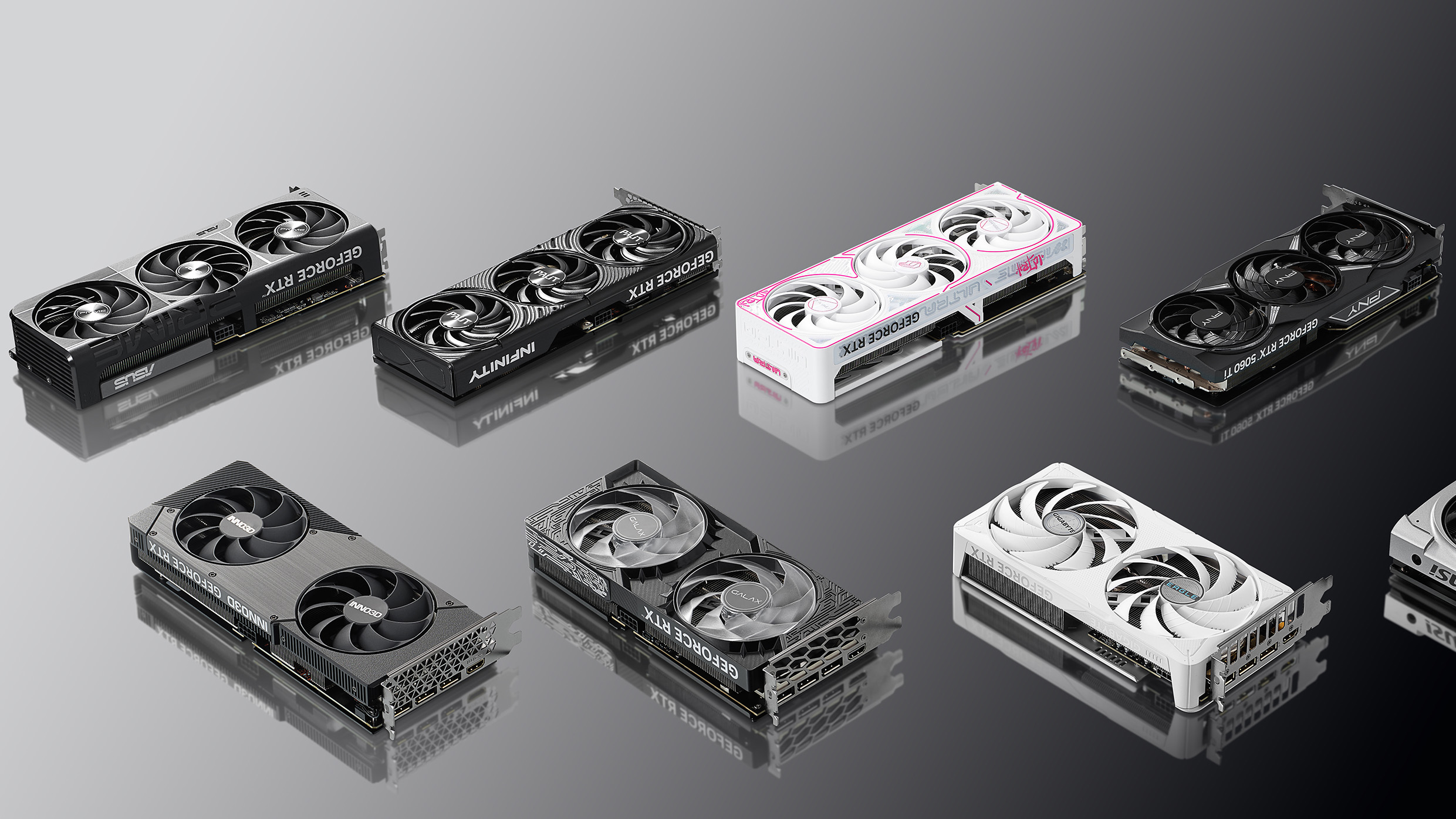Laptop Mag Verdict
Dell's XPS 15 combines style and speed using a slick design, resulting in a premium 15-inch system that's a joy to use.
Pros
- +
Sleek and slim design
- +
Attractive aluminum and carbon fiber body
- +
Roomy touchpad
- +
1080p model gets over 10 hours of battery life
- +
Optional super-sharp UHD touch screen
- +
Optional Nvidia GPU
Cons
- -
UHD model has significantly worse battery life
- -
Color temp on the UHD model's screen is off
- -
Awkward webcam location
Why you can trust Laptop Mag
[sc:section]
After the success of its super-slim XPS 13, Dell decided to apply the same treatment to its line of premium 15-inch notebooks, and it's a formula that works marvelously. On the XPS 15 (starting at $999), Dell offers the brilliant aluminum and carbon fiber design that debuted on the XPS 13, but with a bigger 15.6-inch screen and optional extras, including a UHD screen and Nvidia 960M graphics. To see how this larger XPS performs, we tested not one, but two configurations: an $1,800 Intel Core-i7 model with a 1920 x 1080 non-touch display and Nvidia 960M graphics, and a $2,100 model upgraded with Dell's dazzling UHD touch screen. One model is a proper tool for serious productivity, while the other looks like a mobile graphics pro's dream machine.
So how do these systems stack up to the myriad competing notebooks, including the long-standing artist's tool-of-choice, the MacBook Pro?
[sc:adsale /] [/sc:section][sc:section][sc:subheading text="Design" dir="left" /]
The XPS 15 takes the design principles from Dell's top-notch XPS 13 and upsizes it for a larger system while still keeping the weight and thickness to a minimum. Both in feel and design, the XPS 15 matches up well against any other premium 15-inch on the market, including the vaunted MacBook Pro. The lid and bottom panels are constructed out of smooth brushed aluminum, while the interior features a light but durable carbon-fiber deck coated with a subtle soft-touch finish.
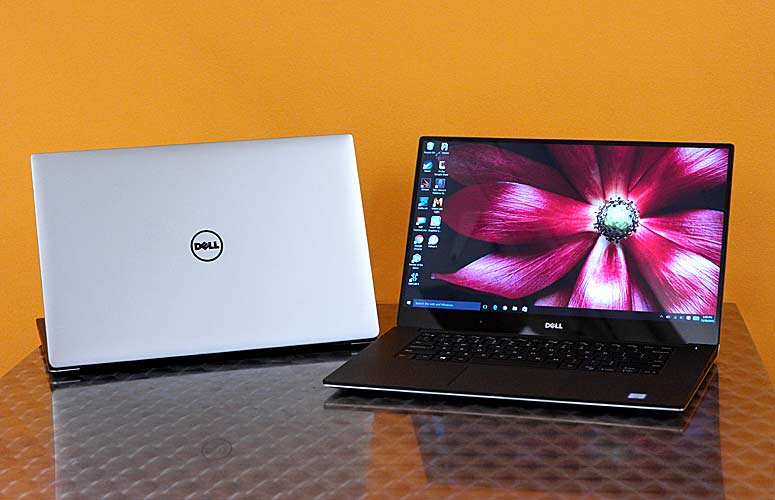
The tapered front edge enlarges slightly as you move back toward the hinge, providing enough room for three USB 3.0 ports (including one Type-C port with speedy Thunderbolt 3 support), HDMI, an SD card reader and a headset jack. The larger 15-inch size also means there's more room on the inside, which Dell puts to good use by offering an optional Nvidia GTX 960M GPU for those who need it.
| Dell XPS 15 Size | |
| Weight | 4.4 pounds |
| Dimensions | 14.06 x 9.27 x 0.66inches |
The space savings become apparent when you compare the XPS 15 to some of its competition, including the 2015 15-inch MacBook Pro, the Asus ZenBook Pro UX 501 and the Toshiba Satellite Radius P55. Measuring 14.06 x 9.27 x 0.66 inches at its thickest and weighing 4.4 pounds, the XPS 15 is thinner and lighter than all of them, with the closest being the MacBook Pro at 14.13 x 9.73 x 0.71 inches and 4.49 pounds.
[/sc:section][sc:section][sc:subheading text="Display" dir="left" /]
The 15.6-inch UHD touch screen on our fully loaded XPS 15 is a spectacular sight to behold. But it comes with one nagging flaw.
On the plus side, the UHD XPS 15's sRGB color range of 191.4 percent (131.9 percent of Adobe RGB) is one of the highest marks we've ever seen, and the 3840 x 2160 resolution means video editors can watch 4K videos at their native res without needing a separate display.
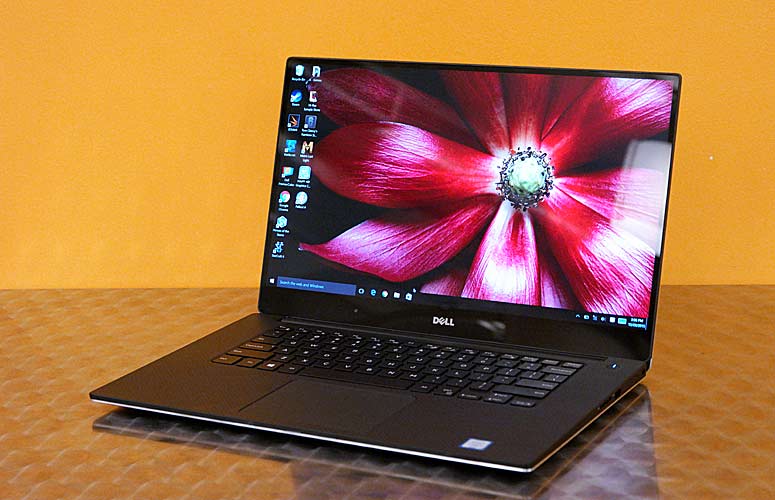
The super-rich and saturated colors were a delight for the eyes, and the UHD XPS 15 completely smashes the color range of other systems, such as the 2015 MacBook Pro (86 percent), the Asus UX 501 (88.5 percent) and the Toshiba Satellite Radius P55 (95 percent).
| Dell XPS 15 Display: Test Results | ||
| Benchmark | Score | How it Compares |
| Brightness (1080p) | 382 nits | Very Strong |
| Brightness (UHD) | 285 nits | Strong |
| Color Gamut (1080p, sRGB) | 72.9 percent | Below Average |
| Color Gamut (UHD, sRGB) | 191 percent | Very Strong |
However, even with Dell's included Premier Color display software, the display has a hard time achieving a neutral color balance. This means pictures and videos looked a little off, and no combination of display tweaks that we tried corrected the issue. For most people, this might not be a big deal, but on a system like the UHD XPS 15, which would be an ideal machine for photo or video editors, it means you can't trust the colors you see on-screen.
At a 6500K color temp, which should offer dead-on whites with no color cast, the UHD XPS 15's display skewed too blue and magenta, which meant that when I watched the latest Deadpool trailer, Wade Wilson's signature red Spandex looked a little more purple than it did on other displays.
I've alerted Dell about this issue so we're hoping the company can come up with a software fix, because it would be a heartbreaker for a display this good to dragged down by inaccurate color.
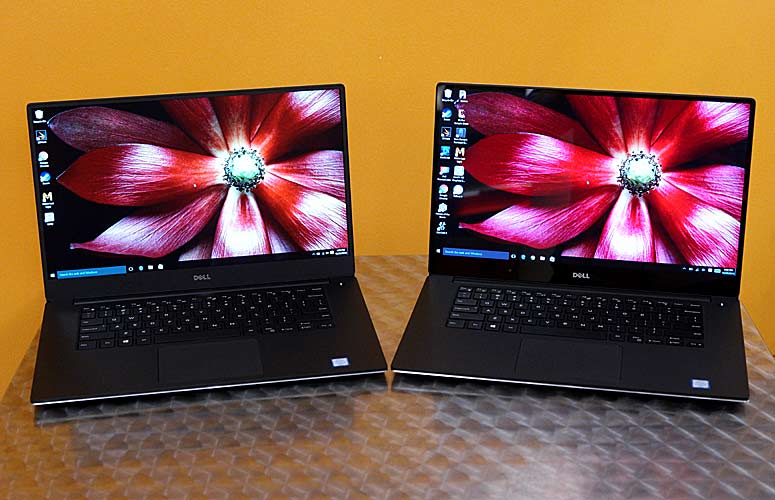
If you're more focused on business or want to save some money, the non-touch model features a matte 1080p screen. Even though that panel is not nearly as colorful or vibrant as the UHD model (at 71.9 percent sRGB), it features much better brightness and enhanced readability " especially on pages with white backgrounds.
The XPS 15's display offers good brightness in both versions, which we recorded at 285 nits for the UHD model, and an even brighter 382.2 nits for the non-touch 1080p model. Both versions featured spot-on color accuracy that netted a Delta-E rating of 0.7 (UHD) and 0.51 (1080p), although that doesn't tell the whole story as our tool only checks the primary colors of red, green and blue. (Numbers closer to zero are best.) Apple's 2015 MacBook Pro with Retina Display hit a bright 303 nits, but it has a lower-res 2880 x 1800 display than the XPS 15.
Asus' UX501 also has a UHD display, but it's not a touch screen, and its 258 nits of brightness and Delta-E of 1.4 couldn't match the XPS 15's stats. Toshiba's P55 was even further behind with brightness that measured only 217 nits, although its 1.1 Delta-E was pretty good.
[/sc:section][sc:section][sc:subheading text="Keyboard and Touchpad" dir="left" /]
The XPS 15 features a spacious keyboard with bright backlighting, although its 1.39mm travel distance is a little shallow. Thankfully, the keys' 60-gram actuation weight provides enough resistance to stop you from bottoming out too hard. I still aced 10fastfingers.com's typing test with 85 words per minute, which is higher than my typical range of 75 to 80 wpm.
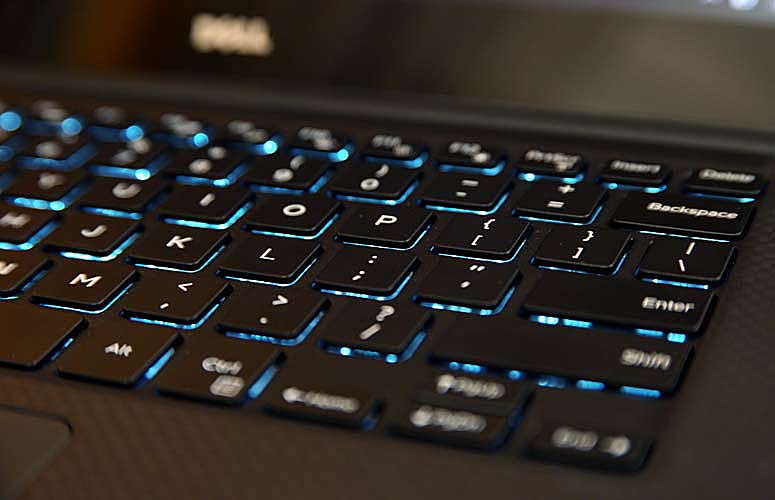
Another way Dell took advantage of the XPS 15's increased real estate is with its 4 x 3-inch touchpad. There's tons of room to move around, and moving from one corner of the screen to the other was a breeze; that's another bonus for mobile artists and editors. As expected, response to mouse movements, left and right clicks, and multi-finger gestures was snappy.
[/sc:section][sc:section][sc:subheading text="Performance" dir="left" /]
Our $2,100 XPS 15 came loaded to the brim with a 6th-gen Intel Core i7-6700HQ CPU, 16GB of RAM, 512GB of NVMe storage and an Nvidia 960M GPU (we'll get to that in a bit). Meanwhile the $1,800 model we tested features the exact same setup, minus the UHD screen. These specs make the XPS 15 a speedy mobile workhorse that chews through things like spreadsheets and multiple PDFs with ease, even with multiple 1080p video streams running in the background.
[sc:benchmarks productName="Dell XPS 15" /]
In Geekbench 3, which measures overall system performance, the UHD XPS 15 scored 13,502, while the 1080p model trailed close behind at 13,023. That mark was topped only by the 2015 MacBook Pro (Intel Core i7, 16 GB of RAM and 512GB SSD), which posted a score of 14,423, due in large part to its blazing storage speed. The Asus UX 501 and the Toshiba P55 were both slower, at 11,887 and 6,053, respectively.
On our spreadsheet productivity test, the XPS 15s matched 20,000 names and addresses in an average of 3 minutes and 36 seconds (3:35 for the 1080p model, 3:36 for the UHD version). By comparison, the MacBook Pro, the Asus UX 501 and the Toshiba P55 were all 20 to 60 seconds slower than the times put up by the Dells.
The XPS 15's 512GB SSD features support for NVMe (non-volatile memory express) data transfer, which offers better storage speeds than a traditional SSD. However, the 254 MBps transfer rate of the UDH XPS 15's SSD was less than half the speed of the MacBook Pro's 512GB SSD (636 MBps) and also quite a ways behind the 508 MBps from Asus UX 501. Toshiba's P55 brought up the rear with a rate of 212 MBps from its 512GB SSD.
Interestingly, the SSD on the 1080p version of the XPS 15 was faster than the UHD version, at 339.2 MBps, but still slower than both the Apple and the Asus.
[/sc:section][sc:section][sc:subheading text="Graphics" dir="left" /]
If you opt for the Nvidia GeForce GTX 960M GPU such as on our review units, you'll get a machine with 2GB of video RAM that's capable of editing photos and videos quickly. You'll even be able to do some pretty serious gaming too, as long as you don't mind reducing the resolution to 1920 x 1080.
In 3DMark's Fire Strike graphics test, the 960M-equipped XPS 15 posted a potent score of 3,949. Asus' UX 501, which also features a 960M GPU, posted a similar score of 3,854, while Toshiba's P55, which only has integrated graphics, recorded a score of 673.
The XPS 15 with Nvidia 960M graphics put up 95 frames per second in World of Warcraft at 1920 x 1080 and ultra-settings, while the Apple MacBook Pro languished at just 22 fps at the same settings.
When we played Bioshock: Infinite at 1920 x 1080, the XPS 15 put out a playable 33 fps on high settings, which was just slightly behind the UX501's mark of 41 fps.
[/sc:section][sc:section][sc:subheading text="Battery Life" dir="left" /]
Depending on the screen, battery life on XPS 15 varies from pretty good to great. On the Laptop Mag Battery Test (continuous Web surfing over Wi-Fi at 100 nits of brightness), the UHD model lasted just 6 hours and 35 minutes, while the 1080p model soldiered on almost another 4 hours for a time of 10:26. Asus' UX 501 was unimpressive at 4:25 and the Toshiba P55 wasn't much better at 4:52. At 9:02, Apple's MacBook Pro was 1.5 hours short of the 1080p model's runtime, but 2.5 hours better than the UHD version.
| Laptop | Battery Life |
| Dell XPS 15 (UHD) | 6:36 |
| Dell XPS 15 (1080p) | 10:26 |
| Category Average | 5:45 |
[/sc:section][sc:section][sc:subheading text="Webcam" dir="left" /]
The one drawback to the XPS 15's bezel-less Infinity Display is that it forces Dell to put the webcam below the display, to the left of the Dell logo. When you're in a video call, the camera is often looking up at the bottom of your chin, instead of being at eye-level the way it is on pretty much every other laptop.
Thankfully, the 720p webcam takes decent photos, as seen in a test shot I took in a room with challenging lighting that captured fairly accurate colors and good details in my face. As expected, there's a little image noise, but the most distracting part is that the background of the photo is the ceiling due to the webcam's upward angle.
[/sc:section][sc:section][sc:subheading text="Configurations" dir="left" /]
The XPS 15 starts at $1,000 for a 15.6-inch 1920 x 1080 display, Intel Core i3 CPU, 8GB of RAM, 32GB SSD, 500GB HDD and goes up from there. Our $1,800 model has an Intel Core i7-6700HQ chip, 16GB of RAM, 512GB SSD and Nvidia 960M graphics, while the $2,100 model tosses in a UHD touch screen on top of that.
If you want it all, you can throw down for a $2,750 model, which comes with an even larger, 1TB SSD. However, if you're looking for a more powerful GPU than the Nvidia 960M, you'll have to move over to one of Dell's workstations or its line of Alienware gaming notebooks.
| Dell XPS 15 Cost By Configuration | ||||
| Config | Screen | CPU | RAM / Storage | Price |
| Base Model | 1920 x 1080 | Core i3-6100H | 8GB / 500GB HDD | $999 |
| Recommended | 3840 x 2160 | Core i7-6700HQ | 16GB / 512GB SSD | $2299 |
| Mid-Range | 1920 x 1080 | Core i7-6700HQ | 8GB / 256GB SSD | $1499 |
[/sc:section][sc:section][sc:subheading text="Software and Warranty" dir="left" /]
The XPS 15 comes loaded with Windows 10 and features a one-year limited hardware warranty as standard. However, if you're looking for an extra bit of care and support, you can opt for Dell's Premium Support for one, two or three years for around $85 a year, which offers on-site service accidental damage protection and automatic error detection.
There's a little bloat onboard, such as McAfee LiveSafe and Candy Crush, along with trials for applications like Dropbox and Microsoft Office, but nothing that's too intrusive or will take too long to uninstall.
[sc:adcompare /] [/sc:section][sc:section][sc:subheading text="Bottom Line" dir="left" /]
The XPS 15 is a high-end 15-inch laptop that looks to be a lot of things to a lot of people, and on almost every front, it succeeds with flying colors. Frequent travelers toting the 1080p model will appreciate its over 10 hours of battery life, strong performance, solid build and good looks. If you can afford to spend more and have 4 fewer hours of battery life, consider buying Dell's laptop with its UHD screen, but be aware of its inaccurate color representation.
If you don't need Windows, a MacBook Pro, with its more accurate display, is still a better choice for professional graphics work. However, if you want the best 15-inch Windows Laptop, the XPS 15 should be at the top of your list.
- Laptops with the Longest Battery Life
- Best 2-in-1s (Laptop/Tablet Hybrids)
- Best Ultrabooks (Thin-and-Light Windows Laptops)
[/sc:section]
Dell XPS 15 (Dec. 2015) Specs
| Bluetooth | Bluetooth 4.1 |
| Brand | Dell |
| CPU | 2.6-GHz Intel Core i7-6700HQ CPU |
| Card Slots | SD memory reader |
| Company Website | www.dell.com |
| Display Size | 15.6 |
| Graphics Card | Nvidia GeForce GTX 960M |
| Hard Drive Size | 512GB |
| Hard Drive Speed | n/a |
| Hard Drive Type | SSD |
| Native Resolution | 3840 x 2160 |
| Operating System | Windows 10 |
| Ports (excluding USB) | USB 3.0, Headphone/Mic, SD card slot, Thunderbolt 3 |
| RAM | 16GB |
| Size | 14.06 x 9.27 x 0.45-0.66-inches |
| Touchpad Size | 4 x 3-inches |
| USB Ports | 3 |
| Video Memory | 2GB |
| Warranty/Support | one-year limited hardware warranty |
| Weight | 4.4 pounds |
| Wi-Fi | 802.11ac |
| Wi-Fi Model | DW1830 3x3 802.11ac 2.4/5GHz + Bluetooth 4.1 |
